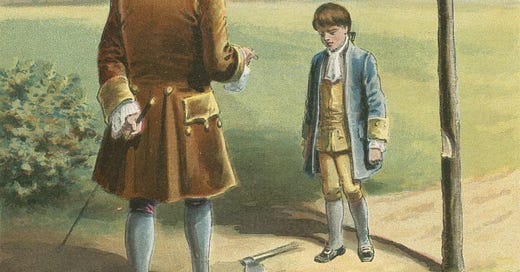The most famous tale from George Washington’s childhood tells of a young boy gifted a hatchet, which he used to chop at a cherry tree. When his father, Augustine, asked who had done it, George confessed, reportedly declaring, “I cannot tell a lie.” Moved by his honesty, his father embraced him, saying his truthfulness was worth more than a thousand trees.
In truth, there is no evidence that this event—or even such a close relationship between George and his father—ever occurred. Augustine Washington died when George was just 11 years old. The story was entirely fabricated by Mason Locke Weems, an itinerant bookseller and minister, who wrote one of the first biographies of Washington. Titled The Life and Memorable Actions of George Washington, it was first published in 1800, just a year after Washington’s death. The cherry tree anecdote didn’t appear until the fifth edition in 1806. Weems’s book became a runaway success, thanks in part to its focus on Washington’s private virtues and idealized boyhood rather than his public life, and it shaped the image of Washington for generations of American schoolchildren.
This is just one of many well-known historical fabrications that appear in children’s books—so parents, take note. Sorting through these books is an ongoing task, as misinformation abounds, whether the topic is polar bears and wolves or historical figures like Harriet Tubman and George Washington. But for now, let’s be clear: Harriet Tubman did not accidentally get hit in the head as a child—a claim that ranks among the more egregious distortions I’ve come across. Actually, the 2019 film Harriet is one of the most historically accurate portrayals available—whether in books or on screen.



